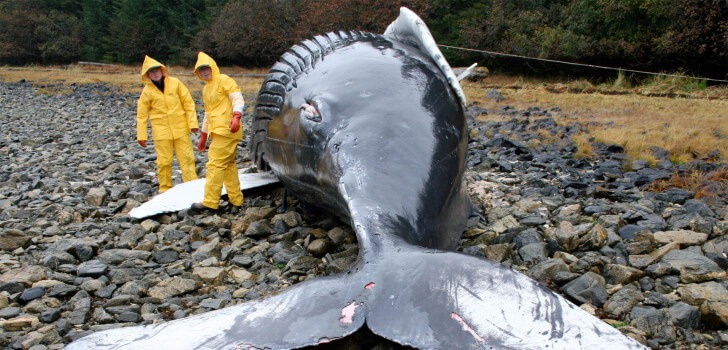A stranded whale was recently discovered in southern Chile in what marine biologists are referring to as the largest and most horrific stranding of large whales on record.
“It was an apocalyptic sight. I’d never seen anything like it,” says Vreni Haussermann of the Huinay Scientific Centre, when describing what is was like to see more than 300 sei whales washed up in a remote inlet of Patagonia.
When Haussermann and other researchers flew over the region, they found at least 337 dead whales, “including bodies and skeletons.”
“There are still a lot of areas we haven’t managed to reach, so it’s likely there are more dead whales,” she says. Marine biologists have yet to determine the cause of death for the sei which are one of the largest whale species. They reach 180 feet in length and 50 tonnes in weight. Many of those in the Chilean stranding are fully grown adults.
Sei whales are capable of swimming at up to 35 mph and have a normal lifespan of 50 to 70 years. It is estimated there are 80,000 sei whales worldwide.
National Geographic magazine will fund the research to find out how the single largest die off event of its kind has occurred.
The whales do not bear any wounds, which suggests they may have died of a virus or “red tide”, a harmful algal bloom.
Carolina Simon Gutstein of the Universidad de Chile and Consejo de Monumentos Nacionales in Santiago, says although red tides can be caused by sewage and fertilizer, it is “very difficult to find one person or corporation culpable.”
Marine biologists say the warming of the world’s oceans is putting dangerous pressure on whale populations.
There have been larger reported strandings of cetaceans, but these have been much smaller dolphin-like animals like pilot whales. In 1918, 1,000 pilot whales stranded themselves in New Zealand, and in 2000, 600 gray whales were stranded along the North American Pacific Coast from Alaska to Mexico.The most recent mass stranding of whales occurred in February when 200 pilot whales were stranded on a remote beach of New Zealand’s South Island.
What adds intrigue to the Chilean sei whale deaths is that last year, an ancient “whale graveyard” was discovered in Chile’s Atacama Desert. It contained dozens of fossilized whale skeletons, dating back 5 million years ago. Scientist Nick Pyenson of the Smithsonian Institution says an algal bloom probably killed those animals.
Stay Connected